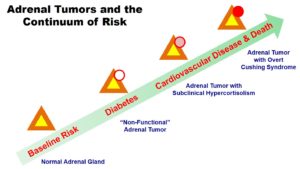Below is a brief summary of our main areas of research investigation:
1) Primary Aldosteronism: What is the range of clinically-relevant autonomous aldosterone excess that we should recognize and treat? What are the consequences of not recognizing milder forms of autonomous aldosterone secretion? What causes primary aldosteronism? What is the best way to treat primary aldosteronism once it is diagnosed? These are key questions we have investigated, and continue to investigate, using human physiology studies, longitudinal cohort studies, and intervention designs. We have shown that primary aldosteronism exists across a continuous spectrum, much of which is currently unrecognized.
Key Publications:
- Parksook et al. The Spectrum of Dysregulated Aldosterone Production. JCEM 2024
- Brown et al. The Unrecognized Prevalence of Primary Aldosteronism. Annals of Internal Medicine 2020
- Yozamp et al. Intraindividual Variability of Aldosterone in Primary Aldosteronism. Hypertension 2020
- Yozamp et al. Variability of Aldosterone During AVS in Primary Aldosteronism. American Journal of Hypertension 2020
- Hundemer et al. Cardiometabolic Outcomes and Mortality in Medically Treated Primary Aldosteronism. The Lancet Diabetes & Endocrinology 2018
- Hundemer et al. Incidence of Atrial Fibrillation and Mineralocorticoid Receptor Activity in Patients with Medically and Surgically Treated Primary Aldosteronismc. JAMA Cardiology 2018
- Hundemer et al. Renal Outcomes in Medically and Surgically Treated Primary Aldosteronism. Hypertension 2018
- Brown et al. The Spectrum of Subclinical Primary Aldosteronism and Incident Hypertension. Annals of Internal Medicine 2017
- Nanba & Vaidya et al. Aging and Autonomous Aldosterone Production. Circulation 2017
- Baudrand et al. A Continuum of Renin-Independent Aldosteronism in Normotension. Hypertension 2017
- Hundemer et al. Renin Phenotypes Characterize Vascular Disease, Autonomous Aldosteronism, and Mineralocorticoid Receptor Activity. JCEM 2017
- Omata et al. Genetic and Histopathologic Inter-Tumor Heterogeneity in Primary Aldosteronism. JCEM 2017
2) The Genetic and Environmental Risk Factors for Developing Pheochromocytoma-Paraganglioma Syndromes and Adrenal Cortical Carcinoma: What genetic and environmental exposures contribute to the pathogenesis of pheochromocytoma and adrenal carcinoma? How can genetic findings inform our understanding of pathogenesis and treatment? Our research has implicated hypoxia, and mutations that cause cellular pseudohypoxia, as a risk factors for developing chromaffin cell tumors and adrenal carcinoma.
Key Publications:
- Vaidya et al. EPAS1 Mutations and Paragangliomas in Cyanotic Congenital Heart Disease. New England Journal of Medicine 2018
- Opotowsky A, et al. Pheochromocytoma and Paraganglioma in Cyanotic Congential Heart Disease. JCEM 2015
- Else T et al. Adrenocortical Carcinoma and Germline Succinate Dehydrogenase Gene Mutations. European Journal of Endocrinology 2017
3) The Cause and Consequences of Adrenal Neoplasia: Why do adrenal tumors develop? What are the metabolic and cardiovascular consequences once adrenal tumors develop? How can these be prevented or mitigated? Our lab has identified unique risk factors for the development of adrenal neoplasia and has identified cardiometabolic disorders that are associated with having adrenal tumors.
Key Publications:
- Lopez et al. “Non-functional” Adrenal Tumors and the Risk for Incident Diabetes and Cardiovascular Outcomes. Annals of Internal Medicine 2016.
- Hao et al. The Lateralizing Asymmetry of Adrenal Adenomas. Journal of the Endocrine Society 2018.
- Vaidya et al. The Evaluation of Incidentally Discovered Adrenal Masses. Endocrine Practice 2019.

4) Improving Quality of Life for Patients with Addison’s Disease (primary adrenal insufficiency) and Congenital Adrenal Hyperplasia: One one hand, patients with adrenal insufficiency can be treated with hormone supplementation. On the other hand, despite this capability, many patients are not able to achieve the quality of life they desire. How can we tailor the treatment of adrenal insufficiency to improve individual patient quality of life? We have initiated a large-scale project to better quantify quality of life among patients with adrenal insufficiency to better identify modifiable factors to improve health and well-being.
5) The Interaction Between Adrenal- and Calcium-Regulatory Hormones: Reciprocal interactions between these two hormonal systems exist. What role do these interactions have in normal physiology and in pathophysiology?
Key Publications:
Brown JM et al. Human Interventions to Characterize Novel Relationships Between the Renin-Angiotensin-Aldosterone System and Parathyroid Hormone. Hypertension 2014.
Zaheer S et al. Parathyroid Hormone and the use of Diuretics and Calcium-Channel Blockers. Journal of Bone and Mineral Research 2016.
Zaheer S, et al. Angiotensin Converting Enzyme Inhibition and Parathyroid Hormone Secretion. International Journal of Endocrinology 2017

